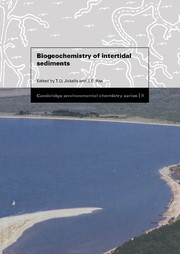Book contents
- Frontmatter
- Contents
- List of contributors
- Preface
- 1 Biogeochemistry of intertidal sediments
- 2 Trace metals in deposited intertidal sediments
- 3 Modelling adsorption and desorption processes in estuaries
- 4 A critical appraisal of the methodology used in studies of material flux between saltmarshes and coastal waters
- 5 Nutrient recycling in intertidal sediments
- 6 An overview of carbon and sulphur cycling in marine sediments
- 7 Microbial activity and diagenesis in saltmarsh sediments, North Norfolk, England
- 8 The behaviour of radionuclides in the coastal and estuarine environments of the Irish Sea
- 9 The sorption of hydrophobic pyrethroid insecticides to estuarine particles: a compilation of recent research
- Index
4 - A critical appraisal of the methodology used in studies of material flux between saltmarshes and coastal waters
Published online by Cambridge University Press: 23 September 2009
- Frontmatter
- Contents
- List of contributors
- Preface
- 1 Biogeochemistry of intertidal sediments
- 2 Trace metals in deposited intertidal sediments
- 3 Modelling adsorption and desorption processes in estuaries
- 4 A critical appraisal of the methodology used in studies of material flux between saltmarshes and coastal waters
- 5 Nutrient recycling in intertidal sediments
- 6 An overview of carbon and sulphur cycling in marine sediments
- 7 Microbial activity and diagenesis in saltmarsh sediments, North Norfolk, England
- 8 The behaviour of radionuclides in the coastal and estuarine environments of the Irish Sea
- 9 The sorption of hydrophobic pyrethroid insecticides to estuarine particles: a compilation of recent research
- Index
Summary
Introduction
In the context of saltmarsh/coastal flux studies, a flux is the net exchange of a substance between these two ecosystems. The fluxes of several types of material, including nutrients, trace metals, herbicides and radionuclides, have been studied by researchers. Although this paper primarily appraises the methodology of nutrient flux estimations, many of the problems are also shared by researchers working on other types of material fluxes.
Since the first detrital flux studies conducted on Sapelo Island, Georgia, USA (Teal, 1962; Odum & de la Cruz, 1967), there has been a research interest in nutrient fluxes between saltmarshes and the adjacent coastal water. The major drive behind this work was to ascertain whether saltmarshes affect the concentration of dissolved inorganic nutrients and detritus (and hence the ecology) of coastal water. The link between saltmarsh processes and coastal productivity may be of relevance to coastal managers who wish to predict the impact of future saltmarsh loss (due to reclamation, erosion or drowning due to sea level rise) or possibly saltmarsh gain (if managed retreat becomes an extensively used strategy for coastal defence in rural areas).
The published flux results indicate that some saltmarshes appear to process nutrients in a very different way to others (Nixon, 1980; Carpenter, 1993). These discrepancies could be due to actual differences in nutrient budgeting caused by variations in saltmarsh characteristics. However, the disparity may be artificial, caused by differences in field methodology and the large uncertainties involved in the calculation of tidal and annual fluxes.
- Type
- Chapter
- Information
- Biogeochemistry of Intertidal Sediments , pp. 59 - 83Publisher: Cambridge University PressPrint publication year: 1997
- 1
- Cited by



